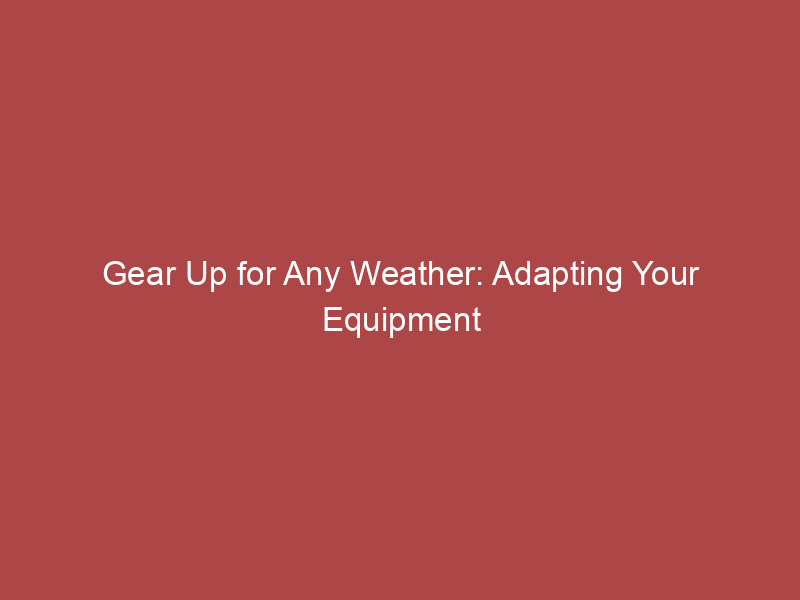
Introduction to Seasonal Gear Adaptation
As the seasons change, so do the conditions we face in our daily lives. This is especially true for those of us who enjoy outdoor activities. Whether you’re a hiker, a camper, or simply someone who enjoys spending time outside, it’s crucial to understand the importance of adapting your gear to the changing weather. In this article, we’ll explore why it’s essential to adjust your equipment for the weather and provide an overview of weather-specific gear.
- Understanding the Importance of Adapting Equipment for Weather
Adapting your gear to the weather is not just about comfort, it’s about safety. Using the wrong equipment in harsh weather conditions can lead to dangerous situations. For example, wearing summer hiking boots in snowy conditions can lead to slips and falls, or even frostbite. Similarly, using a lightweight summer tent in winter conditions can leave you exposed to the cold, leading to hypothermia. Therefore, it’s crucial to use the right gear for the right season.
- Overview of Weather-Specific Gear
Weather-specific gear is designed to protect you from the elements and enhance your performance in different weather conditions. Here are some examples:
| Season | Essential Gear |
|---|---|
| Spring | Rain jacket, waterproof boots, umbrella |
| Summer | Sunscreen, hat, lightweight clothing, hydration pack |
| Fall | Layered clothing, light jacket, gloves |
| Winter | Insulated clothing, winter boots, thermal socks, snow goggles |
By understanding the importance of adapting your gear to the weather and having an overview of weather-specific gear, you can ensure that you’re prepared for any weather condition. Stay safe and enjoy your outdoor adventures!
Weather Gear Adjustments: A Seasonal Guide
As we journey through the year, each season presents its unique weather conditions. This guide will help you adjust your gear to match the season, starting with spring.
Spring Gear Adjustments
Spring is a season of renewal, but it also brings unpredictable weather. It’s crucial to prepare your gear accordingly.
- Preparing for unpredictable spring weather
- Case study: Successful spring gear adaptation
Spring weather can be a mix of sunny days, sudden showers, and cool breezes. It’s important to have versatile gear that can handle these changes. Start by waterproofing your gear to protect against unexpected rain. Lightweight layers are also a must, allowing you to add or remove clothing as temperatures fluctuate.
Let’s consider the case of a group of hikers who embarked on a spring trek. They prepared for the unpredictable spring weather by packing waterproof jackets, moisture-wicking clothing, and sun protection gear. Despite experiencing a mix of sun, rain, and wind during their trek, they remained comfortable and safe thanks to their well-adapted gear.
Adapting your gear for spring requires thoughtful preparation. By anticipating the unpredictable weather conditions, you can ensure you’re equipped for whatever the season throws your way.
Summer Gear Adjustments
When the summer season comes around, it’s time to adjust your outdoor gear to suit the hot weather. The key is to adapt your equipment to the season’s conditions to ensure comfort and safety during your outdoor adventures.
- Adapting Outdoor Gear for Hot Weather
- Choose clothing made from lightweight materials that wick away sweat and keep you cool.
- Opt for gear with built-in sun protection to shield your skin from harmful UV rays.
- Stay hydrated by carrying a water bottle or hydration pack.
- Wear a hat and sunglasses to protect your head and eyes from the sun.
- Key Takeaway: The Importance of Lightweight and Breathable Gear
Adapting your outdoor gear for summer is all about staying cool and protected from the sun. Here are some tips to help you adjust your gear:
Remember, the right gear can make a significant difference in your comfort and safety during your summer outdoor activities.
The key takeaway for summer gear adjustments is the importance of lightweight and breathable gear. Heavy, non-breathable gear can lead to overheating and discomfort, which can ruin your outdoor experience and even pose health risks.
| Gear Type | Why It’s Important |
|---|---|
| Lightweight Clothing | Helps you stay cool and reduces fatigue. |
| Breathable Footwear | Prevents your feet from sweating and developing blisters. |
| Hydration Gear | Keeps you hydrated and helps prevent heat-related illnesses. |
By choosing lightweight and breathable gear, you can enjoy your summer outdoor activities without worrying about the heat.
Fall Gear Adjustments
As the leaves begin to change color and the temperature starts to drop, it’s time to adjust your outdoor gear accordingly. Let’s explore how to transition from summer to fall gear and look at some effective examples of fall gear changes.
-
Transitioning from Summer to Fall Gear
The transition from summer to fall gear involves a shift from lightweight, breathable materials to more insulating and water-resistant ones. The key is to find a balance between staying warm and maintaining mobility.
Start by swapping your summer hat for a beanie to protect your ears from the cold. Replace your lightweight summer jacket with a heavier, insulated one. Consider adding a scarf and gloves to your gear as well. Your footwear should also change – opt for waterproof boots instead of sandals or sneakers.
Remember, the weather can change quickly in the fall, so it’s important to layer your clothing. This allows you to add or remove layers as needed, keeping you comfortable throughout the day.
-
Example: Effective Fall Gear Changes
Let’s consider an example of effective fall gear changes. John, an avid hiker, made some strategic adjustments to his gear as summer transitioned into fall.
Summer Gear Fall Gear Lightweight hat Insulated beanie Thin jacket Heavier, insulated jacket Sandals Waterproof boots By making these changes, John was able to stay warm and dry during his fall hikes, without sacrificing mobility or comfort. His example shows how thoughtful gear adjustments can enhance your outdoor experiences in the fall season.
Winter Gear Adjustments
When the winter season approaches, it’s crucial to adjust your gear to withstand the cold and snowy weather. This section will guide you through the process of adapting your equipment for winter conditions and provide a case study of a successful winter gear adaptation.
- Adapting Equipment for Cold and Snowy Weather
Adapting your gear for winter is all about warmth and safety. The cold and snowy conditions of winter require special considerations to ensure your equipment can handle the harsh environment.
Start by inspecting your gear. Check for any damages that could worsen in cold temperatures. Next, consider the materials of your gear. Materials like wool and synthetic fibers are excellent for insulation, keeping you warm in the cold. For snowy conditions, waterproofing your gear is essential. This prevents moisture from seeping into your equipment, which can lead to freezing and damage.
Remember, the goal is to stay warm and dry in winter conditions. So, make sure your gear is well-insulated and waterproofed.
- Case Study: Successful Winter Gear Adaptation
Let’s look at a case study of successful winter gear adaptation. John, an avid hiker, decided to continue his outdoor adventures even in the winter. He started by inspecting his gear and identified a few items that needed replacement due to wear and tear. He then invested in woolen clothing for insulation and waterproof boots for the snowy trails.
John also waterproofed his backpack to protect his belongings from the snow. With these adjustments, he was able to continue his hiking adventures throughout the winter, staying warm and dry despite the cold and snowy conditions.
This case study illustrates the importance of adapting your gear for winter. By taking the necessary steps, you can ensure your safety and comfort during your winter adventures.
| Key Winter Gear Adjustments | Benefits |
|---|---|
| Insulation with wool or synthetic fibers | Keeps you warm in cold conditions |
| Waterproofing gear | Prevents moisture and freezing damage |
| Inspecting and replacing damaged gear | Ensures safety and durability |
In conclusion, adapting your gear for winter is crucial for your safety and comfort. By taking the necessary steps, you can enjoy your outdoor activities even in the cold and snowy conditions of winter.
Weather-Proof Gear: A Must for Any Season
Whether you’re an outdoor enthusiast or someone who simply enjoys a casual stroll in the park, weather-proof gear is essential. It’s not just about comfort, but also about safety and protection. Let’s delve into the importance of weather-resistant equipment and explore some examples of effective weather-proof gear.
- Understanding the Importance of Weather-Resistant Equipment
Weather-resistant equipment is designed to protect you from the elements. Whether it’s a downpour, a snowstorm, or a scorching summer day, the right gear can make all the difference. It keeps you dry during rain, warm in cold weather, and cool in the heat. More than that, it can prevent health issues like hypothermia or heatstroke.
According to a study by the National Outdoor Leadership School, 70% of outdoor injuries are weather-related. This statistic highlights the crucial role of weather-proof gear in outdoor safety.
- Examples of Effective Weather-Proof Gear
There’s a wide array of weather-proof gear available, each designed for specific weather conditions. Here are a few examples:
| Gear | Weather Condition |
|---|---|
| Waterproof Jacket | Rainy |
| Insulated Boots | Snowy |
| Sun-protective Clothing | Sunny |
A waterproof jacket, for instance, is a must-have for rainy seasons. It keeps you dry and comfortable, even during heavy downpours. Insulated boots are essential for snowy conditions, providing warmth and preventing frostbite. And for sunny weather, sun-protective clothing can shield you from harmful UV rays.
Remember, the right gear can make your outdoor experiences safer and more enjoyable, regardless of the weather. So, invest in quality weather-proof equipment and embrace the great outdoors in any season.
Seasonal Outdoor Equipment: What You Need to Know
When it comes to outdoor activities, the right equipment can make all the difference. But did you know that the gear you need can change with the seasons? In this section, we will explore how to choose the right gear for each season, and the role weather plays in this decision.
Choosing the Right Gear for Each Season
Choosing the right gear for each season is not just about comfort, it’s also about safety. Let’s delve into the factors you need to consider and understand the impact of weather on your gear selection.
- Factors to Consider When Choosing Seasonal Gear
- Key Takeaway: The Role of Weather in Gear Selection
When choosing your gear, you should consider the type of activity you’ll be doing, the expected weather conditions, and the duration of your outdoor adventure. For instance, if you’re going hiking in the winter, you’ll need warm, insulated clothing, sturdy boots, and possibly snowshoes. In the summer, you might need lightweight clothing, a hat for sun protection, and a hydration pack.
Weather plays a significant role in gear selection. In hot weather, you need gear that is lightweight and breathable to help keep you cool. In cold weather, you need gear that is insulated and waterproof to keep you warm and dry. Always check the weather forecast before you head out and plan your gear accordingly.
In conclusion, choosing the right gear for each season is crucial for your comfort and safety during outdoor activities. By considering the factors we’ve discussed and understanding the role of weather, you can make informed decisions about your gear. Remember, the right gear can enhance your outdoor experience, no matter the season.
Maintaining Your Gear Through the Seasons
Regardless of the season, your outdoor gear needs regular maintenance to ensure its longevity and optimal performance. Let’s delve into the best practices for gear maintenance and explore a case study that highlights the impact of regular maintenance on gear longevity.
- Best Practices for Gear Maintenance
Proper gear maintenance is crucial for the lifespan and performance of your equipment. Here are some best practices to follow:
- Clean Your Gear: After every use, make sure to clean your gear. This prevents dirt and grime from causing wear and tear.
- Store Properly: When not in use, store your gear in a cool, dry place. This helps prevent damage from moisture and extreme temperatures.
- Inspect Regularly: Regularly inspect your gear for any signs of damage. Early detection can prevent minor issues from becoming major problems.
- Repair Immediately: If you notice any damage, repair it immediately. This helps maintain the integrity of your gear.
- Case Study: The Impact of Regular Maintenance on Gear Longevity
Let’s consider a case study that demonstrates the importance of regular gear maintenance. A group of hikers, Group A, regularly maintained their gear, while another group, Group B, did not. After a year, Group A’s gear was still in excellent condition, while Group B’s gear showed significant signs of wear and tear.
| Group | Gear Condition After One Year |
|---|---|
| Group A (Regular Maintenance) | Excellent |
| Group B (No Maintenance) | Significant Wear and Tear |
This case study clearly illustrates that regular maintenance significantly extends the lifespan of outdoor gear. Therefore, it’s essential to incorporate these best practices into your routine to get the most out of your gear, regardless of the season.
Gear Adaptation for Seasons: Tips and Tricks
Adapting your gear to the changing seasons is not only smart but also essential for your comfort and safety. In this section, we will share some quick and easy tips and tricks for gear adjustments that you can make as the weather changes. We will also discuss the benefits of being proactive in adapting your gear to the seasons.
- Quick and Easy Gear Adjustments for Changing Weather
Whether you’re hiking, camping, or just spending time outdoors, the weather can change quickly and unexpectedly. Here are some quick and easy gear adjustments you can make to stay comfortable and safe:
- Layering: Layering your clothing allows you to add or remove layers as the temperature changes. Start with a moisture-wicking base layer, add an insulating middle layer, and finish with a waterproof outer layer.
- Footwear: Choose footwear that is appropriate for the weather. Waterproof boots are essential for rainy or snowy conditions, while breathable shoes are better for hot weather.
- Accessories: Don’t forget about hats, gloves, and scarves. These can be easily added or removed as needed.
- Key Takeaway: The Benefits of Proactive Gear Adaptation
Being proactive in adapting your gear to the seasons has several benefits:
- Comfort: By making the right gear adjustments, you can stay comfortable no matter what the weather is like.
- Safety: Proper gear can protect you from weather-related dangers like hypothermia or heatstroke.
- Enjoyment: When you’re comfortable and safe, you can fully enjoy your outdoor activities.
In conclusion, adapting your gear to the changing seasons is a simple yet effective way to enhance your outdoor experiences. So, be proactive, make the necessary adjustments, and embrace the weather!
Conclusion: Embrace the Weather with Seasonal Gear Changes
As we wrap up our comprehensive guide on seasonal gear adaptation, it’s important to remember the key takeaways. Adapting your outdoor gear to the changing weather conditions is not just about comfort, but also about safety and efficiency.
- Recap of the importance of adapting outdoor gear for weather
- Final thoughts on weather gear adjustments and seasonal gear adaptation
Throughout this guide, we’ve emphasized the importance of adjusting your outdoor gear according to the weather. Whether you’re hiking, camping, or just enjoying a day in the park, the right gear can make all the difference. It can protect you from harsh weather conditions, prevent injuries, and even enhance your overall outdoor experience. Remember, each season brings its own set of challenges and having the right gear can help you tackle them with ease.
Adapting to the weather doesn’t mean you need to invest in a whole new set of gear every season. It’s about making smart choices and adjustments to your existing gear. This could mean adding a waterproof cover to your backpack during the rainy season, or investing in thermal wear for winter camping. The key is to anticipate the weather conditions and prepare accordingly.
In conclusion, embracing the weather with seasonal gear changes is an essential part of outdoor activities. It allows you to enjoy the beauty of each season, while also ensuring your safety and comfort. So, don’t let the weather stop you. Instead, adapt your gear and embrace the change!






